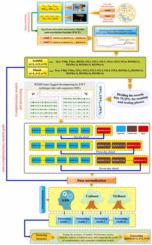Agricultural Water Management ( IF 6.7 ) Pub Date : 2022-05-02 , DOI: 10.1016/j.agwat.2022.107679 Mehdi Jamei , Masoud Karbasi , Anurag Malik , Mozhdeh Jamei , Ozgur Kisi , Zaher Mundher Yaseen

|
The root zone soil moisture (RZSM) is essential for monitoring and forecasting agricultural, hydrological, and meteorological systems. Accordingly, researchers are determined to improve robust machine learning (ML) models to increase the accuracy of the RZSM predictions. This paper designed new complementary forecasting paradigms hybridizing Empirical Wavelet Transform (EWT) and two modern ensemble-based ML models, namely, extreme gradient boosting (XGBoost) and categorical boosting (CatBoost), to forecast long-term multi-step ahead daily RZSM in very cold and very warm semi-arid regions of Iran. For this purpose, the required datasets consisting of soil properties and meteorological information were extracted from the satellite datasets during 2005–2020 for Ardabil and Minab sites. Afterward, the significant lags of RZSM time series and optimal influence candidate inputs were sought based on the partial autocorrelation function (PACF) and mutual information techniques, respectively. Selected lagged components of RZSM time series were decomposed using EWT into different sub-sequences and consequently concatenated with candidate inputs to feed the ensemble ML models to forecast one-, three-, and seven-day-ahead RZSM at each case study. The performance of EWT-CatBoost and EWT-XGBoost and their counterpart standalone approaches was firstly evaluated in forecasting one-, three-, and seven-day-ahead RZSM using satellite data in this study and their accuracy were compared with a standalone kernel ridge regression (KRR) and complementary EWT-KRR models based on several statistical metrics (e.g., correlation coefficient (R), root mean square error (RMSE), Nash–Sutcliffe model efficiency coefficient (NSE)) and diagnostic analysis. The outcomes of testing phase in Ardabil site ascertained that the EWT-CatBoost (for RZSM(t + 1), R= 0.9979, RMSE= 0.0019, and NSE= 0.9985; for RZSM(t + 3), R= 0.9934, RMSE= 0.0035, and NSE= 0.9885; for RZSM(t + 7), R= 0.9489, RMSE= 0.0109, and NSE= 0.8634) outperformed the other models. On the other hand, the EWT-XGBoost model according to its best results (for RZSM(t + 1), R= 0.9911, RMSE= 0.0064, and NSE= 0.9805; for RZSM(t + 3), R= 0.9807, RMSE= 0.0092, and NSE= 0.9589; for RZSM(t + 7), R= 0.9680, RMSE= 0.0120, and NSE= 0.9309) yielded the most promising accuracy in forecasting multi-step ahead daily RZSM followed by the EWT-CatBoost, and EWT-KRR, respectively.
中文翻译:

不同气候下根区土壤水分的长期多步超前预测:基于集合的新型互补数据智能范式
根区土壤湿度 (RZSM) 对于监测和预测农业、水文和气象系统至关重要。因此,研究人员决心改进稳健的机器学习 (ML) 模型,以提高 RZSM 预测的准确性。本文设计了新的互补预测范式,混合了经验小波变换(EWT) 和两个现代基于集成的 ML 模型,即极端梯度提升 (XGBoost) 和分类提升 (CatBoost),以预测长期多步领先每日 RZSM伊朗非常寒冷和非常温暖的半干旱地区。为此,所需的数据集包括土壤特性和气象信息是从 2005-2020 年期间 Ardabil 和 Minab 站点的卫星数据集中提取的。之后,基于偏自相关寻找 RZSM 时间序列的显着滞后和最优影响候选输入函数(PACF)和互信息技术,分别。使用 EWT 将 RZSM 时间序列的选定滞后分量分解为不同的子序列,然后将其与候选输入连接起来,以提供集成 ML 模型以在每个案例研究中预测提前 1 天、3 天和 7 天的 RZSM。在本研究中,首先评估了 EWT-CatBoost 和 EWT-XGBoost 及其对应的独立方法在使用卫星数据预测提前 1 天、3 天和 7 天 RZSM 中的性能,并将其准确性与独立的核岭回归进行了比较(KRR)和基于几个统计指标(例如,相关系数)的互补 EWT-KRR 模型(R)、均方根误差 (RMSE)、Nash-Sutcliffe 模型效率系数 (NSE)) 和诊断分析。Ardabil 站点测试阶段的结果确定 EWT-CatBoost(对于 RZSM(t + 1),R = 0.9979,RMSE = 0.0019,和 NSE = 0.9985;对于 RZSM(t + 3),R = 0.9934,RMSE = 0.0035,NSE=0.9885;对于 RZSM(t + 7),R=0.9489,RMSE=0.0109,NSE=0.8634) 优于其他模型。另一方面,EWT-XGBoost 模型根据其最佳结果(对于 RZSM(t + 1),R= 0.9911,RMSE= 0.0064,和 NSE= 0.9805;对于 RZSM(t + 3),R= 0.9807,RMSE = 0.0092,和 NSE= 0.9589;对于 RZSM(t + 7),R= 0.9680,RMSE= 0.0120 和 NSE= 0.9309) 在预测多步超前每日 RZSM 方面产生了最有希望的准确度,其次是 EWT-CatBoost,并且EWT-KRR,分别。


























 京公网安备 11010802027423号
京公网安备 11010802027423号